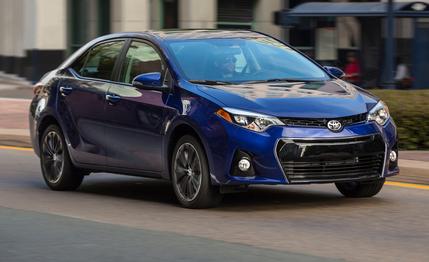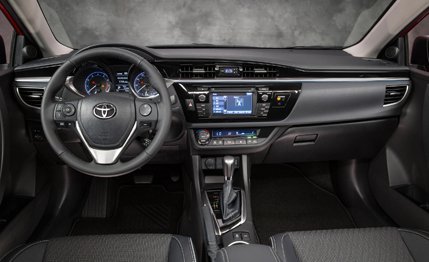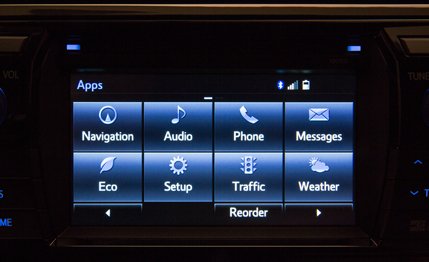
 First Drive Review
First Drive Review
News that quickens the pulses of actuaries everywhere: A new Corolla is shipping to dealerships from Toyota factories in Mississippi and Canada. We've finally driven the 11th-generation 2014 model, and, well, it's a Corolla. A quieter, bigger one with better seats, a smoother ride, crisper steering, a “seven-speed” CVT function that's actually preferable to a traditional automatic, and a special fuel-sipper model rated at 42 mpg. It’s all wrapped in styling that merits the use of the word, and it’s packed with the infotainment features modern marketing demands.
Parked alongside last year's model under San Diego's high August sun, the new Corolla glistens handsomely, looking less like that Nokia candy-bar phone your mother still uses. For all the standard LED headlamps and crisp folds, though, the creative metal bending stops well short of the inspiring Furia concept on which the production model is based. The 2014 Corolla comes only as a sedan—memories of Corolla hatchbacks, wagons, and coupes remain in history's dustbin alongside the hot-hatch FX16 and rear-drive AE86.
Quieter, Smoother
A 3.9-inch wheelbase extension smoothes out sharp ride motions and expands rear-seat legroom—by Toyota's measure, there are 5.1 additional inches of space for stems in the back. The front seats are a significant improvement; the S model's bigger bolsters feel awfully soft for a “sport seat,” but the entire range has added thigh, lumbar, and lateral support. That will make journeys longer than a typical commute less punishing, as will sound-insulating measures (seals, insulation, glass) and the longer overdrive ratios that quell highway hubbub.
The Corolla's traditional L, LE, and S models use a carry-over 1.8-liter twin-cam VVTi four-cylinder, rated at the same 132 hp as it was last year. Efforts were made to minimize mass, but curb weight rises with the added length. You might anticipate a commensurate loss of performance, but the car feels a tad livelier. Credit the pair of new transmissions: a CVT for the shiftless, which offers a “stepped seven-speed” function in S models, and a fresh six-speed manual. Clutch-pedal availability is limited strictly to frugal-minded buyers of the base L model or the indulgent experience seekers who opt for a nearly loaded S.


On the road, the electronically managed CVT—branded CVTi-S—banishes the usual drone of such a transmission, instead emulating the feel of a traditional automatic while being more efficient, quieter, and offering a better range of ratios. It’s certainly among the best CVTs ever but can't mask the 1.8-liter's lack of low-rpm punch. Engaged drivers will prefer the new six-speed manual. The shift throws are long but crisp, and the clutch feel is good. Predictably but sadly, the pedals are so far apart as to negate heel-and-toe downshifts; if you expected Toyota to let you find the brake and gas pedals with the same foot, you haven’t paid attention in a long time.
Drinking Less
The new LE Eco (leak-o?) model has more power (140) but less torque (126 lb-ft versus 128), thanks to Valvematic, a tweak to the variable-valve system that minimizes intake-valve lift at small throttle openings to reduce parasitic pumping losses. Hypermilers can upgrade to Plus (alloys supplant the 16-inch steel wheels, plus fog lamps) or Premium (adds faux leather upholstery) trims. With the “Eco” button/electronic hair shirt enabled—it lives next to the shifter—the computer dials back the climate control and remaps the first half of the throttle travel to be less responsive. The base price for the LE Eco is $19,510, for which you get as high as 42 mpg on the highway. (Other Corollas can manage up to 38 mpg on the highway.)


The base L model keeps the starting price low, although it's hardly a stripper. At $17,610, it's $570 pricier than it was a year ago. You'll settle for 15-inch steel wheels, a groaning four-speed automatic or the fresh manual but will still get the LED lights, Bluetooth connectivity, air conditioning, power locks and windows, and eight airbags. A practical reason to get the stick: The four-speed slushbox returns the worst fuel economy of the bunch, at 27 city and 36 highway, and really has no business being offered in a new car. It’s not that it’s a terrible four-speed, it’s the fact that it is a four-speed in a world where most competitors offer six forward ratios—some from dual-clutch automatics—and some are ramping up to 9- and 10-speed boxes. We wouldn’t be surprised to see it canned in the near future or see Toyota install its newer Eco engine across the board.